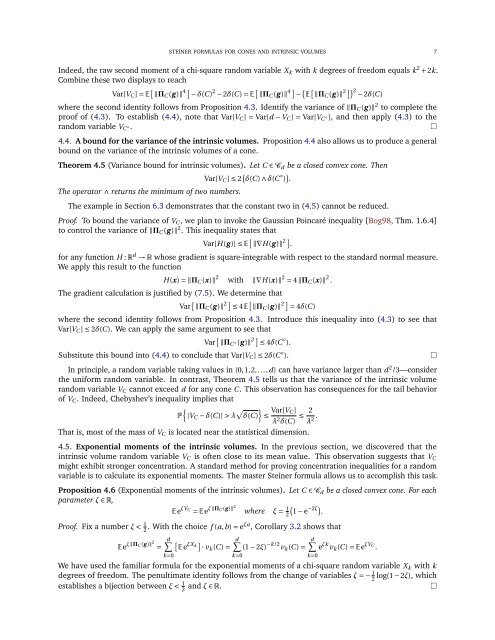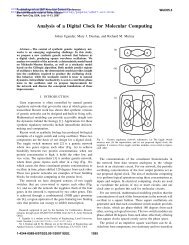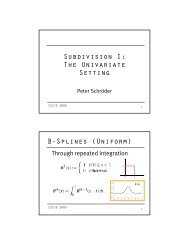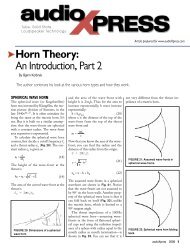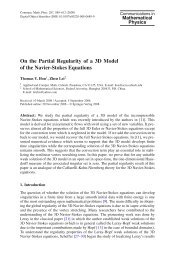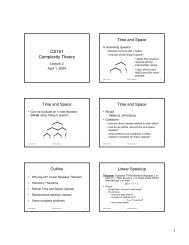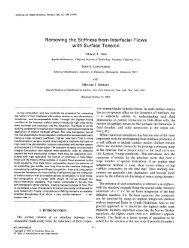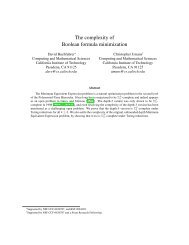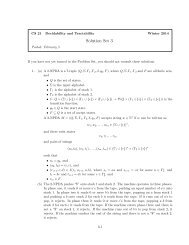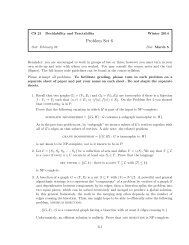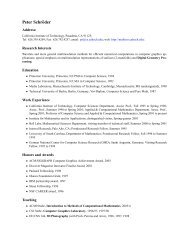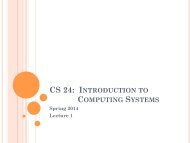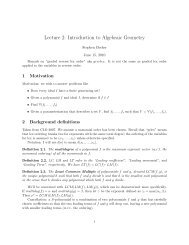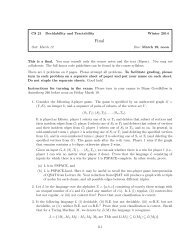From Steiner formulas for cones to concentration of intrinsic volumes
From Steiner formulas for cones to concentration of intrinsic volumes
From Steiner formulas for cones to concentration of intrinsic volumes
You also want an ePaper? Increase the reach of your titles
YUMPU automatically turns print PDFs into web optimized ePapers that Google loves.
STEINER FORMULAS FOR CONES AND INTRINSIC VOLUMES 7Indeed, the raw second moment <strong>of</strong> a chi-square random variable X k with k degrees <strong>of</strong> freedom equals k 2 + 2k.Combine these two displays <strong>to</strong> reachVar[V C ] = E [ ‖Π C (g )‖ 4 ] − δ(C) 2 − 2δ(C) = E [ ‖Π C (g )‖ 4 ] − ( E [ ‖Π C (g )‖ 2 ]) 2 − 2δ(C)where the second identity follows from Proposition 4.3. Identify the variance <strong>of</strong> ‖Π C (g )‖ 2 <strong>to</strong> complete thepro<strong>of</strong> <strong>of</strong> (4.3). To establish (4.4), note that Var[V C ] = Var[d − V C ] = Var[V C ◦], and then apply (4.3) <strong>to</strong> therandom variable V C ◦.□4.4. A bound <strong>for</strong> the variance <strong>of</strong> the <strong>intrinsic</strong> <strong>volumes</strong>. Proposition 4.4 also allows us <strong>to</strong> produce a generalbound on the variance <strong>of</strong> the <strong>intrinsic</strong> <strong>volumes</strong> <strong>of</strong> a cone.Theorem 4.5 (Variance bound <strong>for</strong> <strong>intrinsic</strong> <strong>volumes</strong>). Let C ∈ C d be a closed convex cone. ThenThe opera<strong>to</strong>r ∧ returns the minimum <strong>of</strong> two numbers.Var[V C ] ≤ 2 ( δ(C) ∧ δ(C ◦ ) ) .The example in Section 6.3 demonstrates that the constant two in (4.5) cannot be reduced.Pro<strong>of</strong>. To bound the variance <strong>of</strong> V C , we plan <strong>to</strong> invoke the Gaussian Poincaré inequality [Bog98, Thm. 1.6.4]<strong>to</strong> control the variance <strong>of</strong> ‖Π C (g )‖ 2 . This inequality states thatVar[H(g )] ≤ E [ ‖∇H(g )‖ 2 ] .<strong>for</strong> any function H : R d → R whose gradient is square-integrable with respect <strong>to</strong> the standard normal measure.We apply this result <strong>to</strong> the functionH(x) = ‖Π C (x)‖ 2 with ‖∇H(x)‖ 2 = 4‖Π C (x)‖ 2 .The gradient calculation is justified by (7.5). We determine thatVar [ ‖Π C (g )‖ 2 ] ≤ 4E [ ‖Π C (g )‖ 2 ] = 4δ(C)where the second identity follows from Proposition 4.3. Introduce this inequality in<strong>to</strong> (4.3) <strong>to</strong> see thatVar[V C ] ≤ 2δ(C). We can apply the same argument <strong>to</strong> see thatVar [ ‖Π C ◦(g )‖ 2 ] ≤ 4δ(C ◦ ).Substitute this bound in<strong>to</strong> (4.4) <strong>to</strong> conclude that Var[V C ] ≤ 2δ(C ◦ ).In principle, a random variable taking values in {0,1,2,...,d} can have variance larger than d 2 /3—considerthe uni<strong>for</strong>m random variable. In contrast, Theorem 4.5 tells us that the variance <strong>of</strong> the <strong>intrinsic</strong> volumerandom variable V C cannot exceed d <strong>for</strong> any cone C. This observation has consequences <strong>for</strong> the tail behavior<strong>of</strong> V C . Indeed, Chebyshev’s inequality implies that{P |V C − δ(C)| > λ √ }δ(C)≤ Var[V C ]λ 2 δ(C) ≤ 2 λ 2 .That is, most <strong>of</strong> the mass <strong>of</strong> V C is located near the statistical dimension.4.5. Exponential moments <strong>of</strong> the <strong>intrinsic</strong> <strong>volumes</strong>. In the previous section, we discovered that the<strong>intrinsic</strong> volume random variable V C is <strong>of</strong>ten close <strong>to</strong> its mean value. This observation suggests that V Cmight exhibit stronger <strong>concentration</strong>. A standard method <strong>for</strong> proving <strong>concentration</strong> inequalities <strong>for</strong> a randomvariable is <strong>to</strong> calculate its exponential moments. The master <strong>Steiner</strong> <strong>for</strong>mula allows us <strong>to</strong> accomplish this task.Proposition 4.6 (Exponential moments <strong>of</strong> the <strong>intrinsic</strong> <strong>volumes</strong>). Let C ∈ C d be a closed convex cone. For eachparameter ζ ∈ R,Ee ζV C= Ee ξ‖Π C (g )‖ 2 where ξ = 1 2(1 − e−2ζ ) .Pro<strong>of</strong>. Fix a number ξ < 1 2 . With the choice f (a,b) = eξa , Corollary 3.2 shows thatd∑Ee ξ‖Π C (g )‖ 2 [ ] d∑d∑= EeξX k · vk (C) = (1 − 2ξ) −k/2 v k (C) = e ζk v k (C) = Ee ζV C.k=0k=0We have used the familiar <strong>for</strong>mula <strong>for</strong> the exponential moments <strong>of</strong> a chi-square random variable X k with kdegrees <strong>of</strong> freedom. The penultimate identity follows from the change <strong>of</strong> variables ζ = − 1 2log(1 − 2ξ), whichestablishes a bijection between ξ < 1 2and ζ ∈ R.□k=0□


